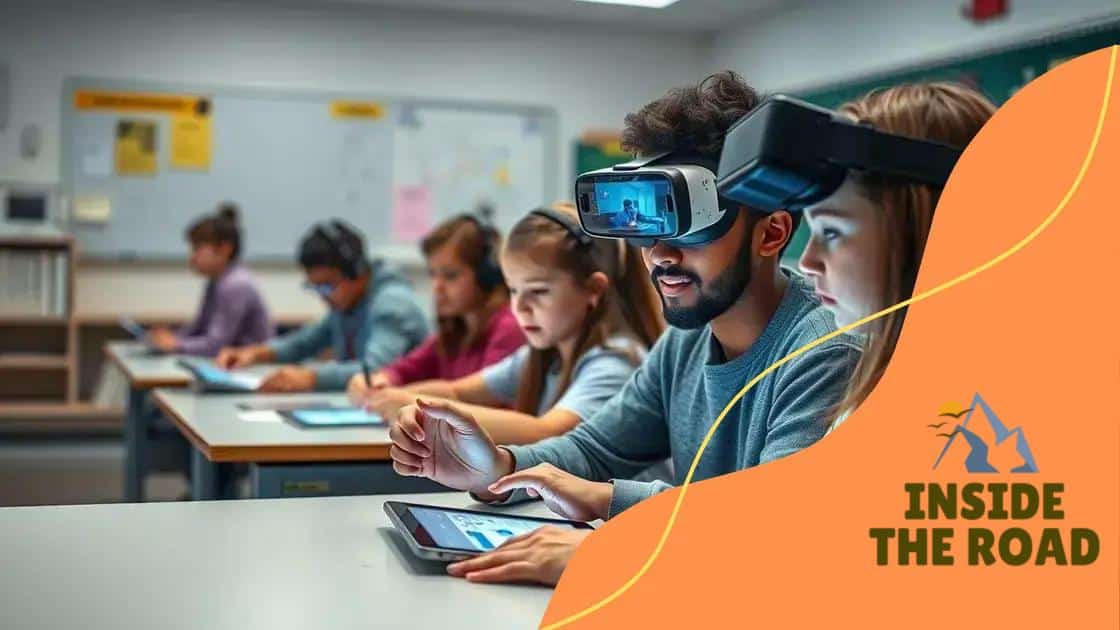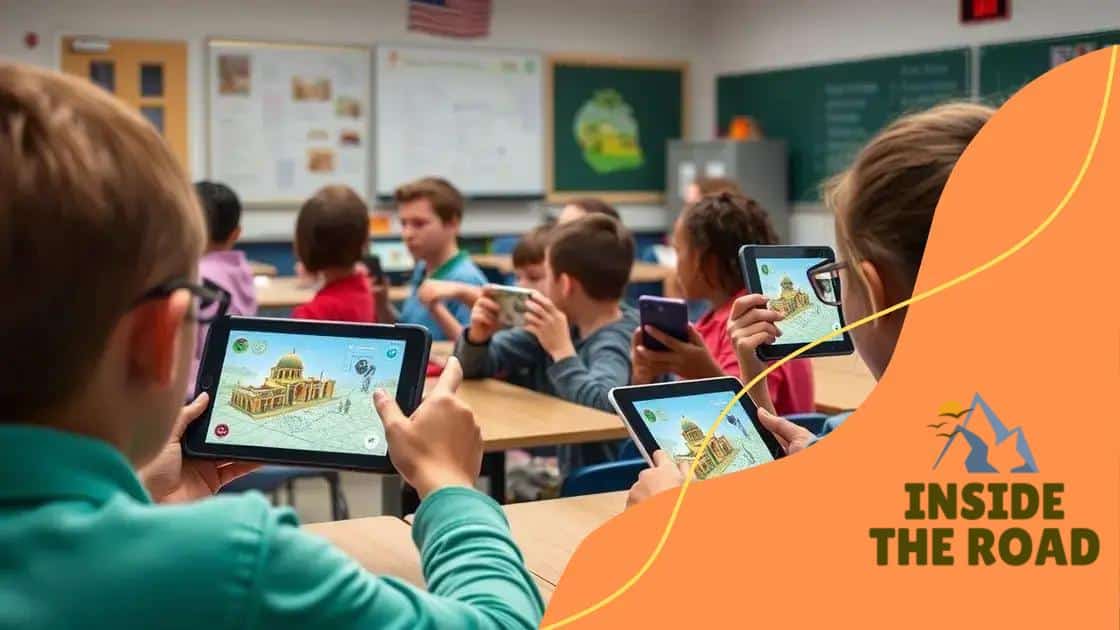How AR is being used for hands-on learning experiences

Augmented reality (AR) enhances hands-on learning by providing immersive, interactive experiences that improve engagement, understanding, and collaboration among students, while personalizing the educational process.
How AR is being used for hands-on learning experiences is redefining education. Imagine exploring history through immersive environments or conducting science experiments virtually. Curious about how this technology enhances real-world learning? Let’s dive in!
Understanding augmented reality in education
Augmented reality (AR) is a technology that overlays digital information onto the real world. It enhances our perception and experience of reality by adding graphics, sounds, and other sensory enhancements.
In education, AR creates exciting opportunities for students to engage with complex subjects. Instead of just reading about a topic, learners can interact with 3D models, simulations, and dynamic visuals that bring concepts to life. This immersive approach makes learning more relatable and impactful.
Key Benefits of AR in Education
Utilizing augmented reality in classrooms offers several advantages:
- Improved engagement: Students are more likely to participate actively when lessons are interactive.
- Enhanced understanding: Difficult concepts become easier to grasp with visual aids.
- Personalized learning: AR can be tailored to meet individual learning styles and needs.
- Real-world application: Learners can see how theoretical knowledge applies to practical situations.
The key to the successful implementation of AR lies in its ability to integrate seamlessly with the existing curriculum. Educators can utilize AR applications to supplement traditional teaching methods while fostering student curiosity. This technology can also facilitate collaboration among peers, as they work together to explore AR-enhanced learning environments.
Furthermore, teachers can incorporate AR in various subjects, from science to arts. For example, a student studying biology might explore a virtual model of a cell, which can help in visualizing structures that are typically too small to see. Similarly, a history class could take a virtual field trip to ancient civilizations, providing students with a deeper connection to their studies.
Incorporating this innovative approach requires thoughtful planning and an understanding of what types of AR content will resonate with students. As educators become more familiar with the technology, they are discovering its potential to transform learning experiences.
Benefits of AR for hands-on learning
Integrating augmented reality (AR) into education can profoundly impact how students learn, especially through hands-on experiences. AR enhances traditional learning by combining digital elements with the physical world, making lessons more engaging and interactive.
One of the most significant benefits of AR for hands-on learning is its ability to create immersive environments. For example, students studying anatomy can interact with 3D models of the human body, helping them visualize complex structures better. This type of interaction can bridge the gap between theory and practice.
Enhanced Engagement
Students are naturally curious, and AR taps into that curiosity. When learners use AR tools, they are more likely to participate actively in lessons. This active participation helps maintain focus and interest. It also enables them to learn at their own pace, discovering information as they explore.
- Visual learning: AR provides visual context, making abstract concepts concrete.
- Interactivity: Engaging with the content fosters deeper understanding.
- Collaboration: Students can work together on AR tasks, strengthening teamwork skills.
The social aspect of AR learning can significantly enhance the educational experience. When students collaborate on AR projects, they share ideas and learn from one another. This creates a sense of community and cooperation in the classroom. Additionally, the fun and engaging nature of augmented reality can motivate students to take on challenges they might otherwise avoid.
Another advantage is the real-time feedback that AR can offer. Instead of waiting for a teacher to grade an assignment, students can immediately see how well they are doing. This immediate feedback loop encourages self-assessment and improvement. The more students can see their progress, the more motivated they become to learn.
Moreover, AR supports personalized learning by catering to different learning styles. Some students may benefit from hands-on, visual interaction, while others may prefer auditory information. AR can adapt to these diverse needs, providing a more tailored learning experience.
Examples of AR applications in classrooms

Augmented reality (AR) opens up a world of possibilities in the classroom. By integrating AR into lessons, educators can create unique learning experiences that captivate students. Here are some practical examples of AR applications that are transforming education.
One notable application is interactive simulations. Students can explore environments and scenarios that would be impossible in a traditional classroom. For instance, in science classes, students can conduct virtual experiments that allow them to observe chemical reactions safely and efficiently.
AR in History Lessons
In history, AR applications enable students to dive into past events. By using their devices, learners can see historical sites come to life. For example, they can point their tablets at a classroom map to see 3D reconstructions of ancient civilizations. This kind of engagement helps students connect with history in a meaningful way.
- Field trips: Virtual visits to museums or historical sites enhance learning.
- Interactive timelines: Students can explore critical events visually and contextually.
- Live reenactments: AR can simulate historical events, allowing students to experience history first-hand.
Another exciting use of AR is in mathematics. Students can visualize complex equations and geometric shapes using AR tools. When they manipulate 3D models, concepts become clearer and easier to understand. This visual approach can significantly aid visual learners who benefit from seeing math in action.
AR applications also foster creativity in art classes. Students can create digital artworks that overlay their physical creations. By using AR apps, they can see their designs come to life in a whole new dimension, merging traditional methods with innovative technology.
Furthermore, language learning can be enhanced with AR. Students can practice vocabulary and pronunciation by interacting with virtual characters that act out scenes or respond to their commands in the target language. This immersive learning can boost retention and confidence in using new languages.
Challenges of implementing AR in education
While augmented reality (AR) offers exciting opportunities in education, several challenges arise when implementing this technology in classrooms. Understanding these challenges is crucial for educators and administrators looking to enhance learning experiences.
One major hurdle is the cost of technology. Schools may face budget constraints that limit their ability to purchase AR devices and software. This financial barrier can prevent many institutions from accessing the latest AR tools that could benefit their students.
Teacher Training
Another significant challenge lies in teacher training. Educators need proper professional development to effectively integrate AR into their teaching. Without ongoing support and training, teachers may feel overwhelmed or unsure about how to utilize AR tools to maximize student engagement.
- Understanding AR tools: Training must include how to operate AR technology effectively.
- Designing AR lessons: Teachers must learn to create engaging lessons that utilize AR effectively.
- Ongoing support: Continuous professional development is necessary for teachers to stay current.
Moreover, technical issues can disrupt the learning process. Challenges like software glitches, connectivity issues, or hardware malfunctions can frustrate both teachers and students. When technology fails, it can detract from the immersive experience that AR intends to provide.
Another concern is the accessibility of AR tools. Not all students have equal access to AR devices or the internet at home, creating disparities in learning opportunities. This digital divide can result in some students missing out on the interactive experiences that AR offers.
Additionally, educators must consider how to balance AR with traditional teaching methods. It’s important to find ways to integrate these technologies without overwhelming students or detracting from essential foundational skills. Maintaining a curriculum that combines different teaching methods ensures that all students can benefit from both worlds.
Future trends in AR learning experiences
The future of augmented reality (AR) in education holds exciting possibilities. As technology advances, AR learning experiences are expected to evolve and become even more integrated into everyday classroom activities. Educators and students alike will benefit from these developments.
One potential trend is the increase in affordable AR hardware. As companies continue to innovate, AR devices are likely to become more accessible for schools with limited budgets. This increased access may help bridge the gap in educational inequality by providing all students with the opportunity to experience AR-based learning.
Personalized Learning with AR
Another trend is the move toward personalized learning. AR can be tailored to meet individual student needs, allowing learners to progress at their own pace. By analyzing data, AR applications can adapt to each student’s learning style and offer customized resources and challenges.
- Adaptive content: AR could provide content that adjusts based on student performance.
- Real-time feedback: Immediate feedback allows students to understand their mistakes better.
- Extended learning: Students can explore topics in-depth beyond the classroom setting.
Moreover, the rise of collaborative AR projects is also on the horizon. As AR tools improve, students can work together on interactive projects that span physical and virtual environments. This collaboration fosters teamwork and communication skills, preparing students for future workplace demands.
Additionally, the integration of gamification elements into AR education is likely to increase engagement. AR can make learning feel similar to playing a game, motivating students to participate actively in their education. By incorporating challenges, rewards, and interactive scenarios, students may find learning more enjoyable and meaningful.
As AR technology continues to be refined, we can expect it to support a range of subjects beyond science and math. Subjects like history, language learning, and even art can benefit from AR experiences, allowing students to engage with content in new and exciting ways.
FAQ – Frequently Asked Questions about AR in Education
What are the main benefits of using AR in classrooms?
AR enhances engagement, improves understanding through visual aids, and fosters collaboration among students while allowing for personalized learning experiences.
What challenges do schools face when implementing AR technology?
Challenges include high costs for technology, the need for teacher training, technical issues, and ensuring equitable access to devices for all students.
How can AR support personalized learning?
AR can adapt content to fit individual learning styles, allowing students to progress at their own pace and receive immediate feedback on their performance.
What does the future hold for AR in education?
The future trends for AR in education include more affordable technology, increased collaborative projects, and the integration of gamification to enhance student engagement.






